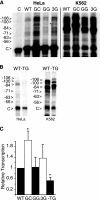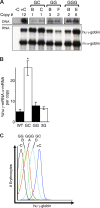Functional analysis of a novel cis-acting regulatory region within the human ankyrin gene (ANK-1) promoter
- PMID: 20479128
- PMCID: PMC2897556
- DOI: 10.1128/MCB.00119-10
Functional analysis of a novel cis-acting regulatory region within the human ankyrin gene (ANK-1) promoter
Abstract
The characterization of atypical mutations in loci associated with diseases is a powerful tool to discover novel regulatory elements. We previously identified a dinucleotide deletion in the human ankyrin-1 gene (ANK-1) promoter that underlies ankyrin-deficient hereditary spherocytosis. The presence of the deletion was associated with a decrease in promoter function both in vitro and in vivo establishing it as a causative hereditary spherocytosis mutation. The dinucleotide deletion is located in the 5' untranslated region of the ANK-1 gene and disrupts the binding of TATA binding protein and TFIID, components of the preinitiation complex. We hypothesized that the nucleotides surrounding the mutation define an uncharacterized regulatory sequence. To test this hypothesis, we generated a library of more than 16,000 ANK-1 promoters with degenerate sequence around the mutation and cloned the functional promoter sequences after cell-free transcription. We identified the wild type and three additional sequences, from which we derived a consensus. The sequences were shown to be functional in cell-free transcription, transient-transfection, and transgenic mouse assays. One sequence increased ANK-1 promoter function 5-fold, while randomly chosen sequences decreased ANK-1 promoter function. Our results demonstrate a novel functional motif in the ANK-1 promoter.
Figures







Similar articles
-
Genome-wide detection of a TFIID localization element from an initial human disease mutation.Nucleic Acids Res. 2011 Mar;39(6):2175-87. doi: 10.1093/nar/gkq1035. Epub 2010 Nov 11. Nucleic Acids Res. 2011. PMID: 21071415 Free PMC article.
-
A dinucleotide deletion in the ankyrin promoter alters gene expression, transcription initiation and TFIID complex formation in hereditary spherocytosis.Hum Mol Genet. 2005 Sep 1;14(17):2501-9. doi: 10.1093/hmg/ddi254. Epub 2005 Jul 21. Hum Mol Genet. 2005. PMID: 16037067
-
Drosophila TFIID binds to a conserved downstream basal promoter element that is present in many TATA-box-deficient promoters.Genes Dev. 1996 Mar 15;10(6):711-24. doi: 10.1101/gad.10.6.711. Genes Dev. 1996. PMID: 8598298
-
Initiation of transcription at the human terminal deoxynucleotidyl transferase gene promoter: a novel role for the TATA binding protein.Biochemistry. 1994 Sep 13;33(36):11025-32. doi: 10.1021/bi00202a023. Biochemistry. 1994. PMID: 8086419
-
The new core promoter element XCPE1 (X Core Promoter Element 1) directs activator-, mediator-, and TATA-binding protein-dependent but TFIID-independent RNA polymerase II transcription from TATA-less promoters.Mol Cell Biol. 2007 Mar;27(5):1844-58. doi: 10.1128/MCB.01363-06. Epub 2007 Jan 8. Mol Cell Biol. 2007. PMID: 17210644 Free PMC article.
Cited by
-
Genome-wide detection of a TFIID localization element from an initial human disease mutation.Nucleic Acids Res. 2011 Mar;39(6):2175-87. doi: 10.1093/nar/gkq1035. Epub 2010 Nov 11. Nucleic Acids Res. 2011. PMID: 21071415 Free PMC article.
References
Publication types
MeSH terms
Substances
Grants and funding
LinkOut - more resources
Full Text Sources
